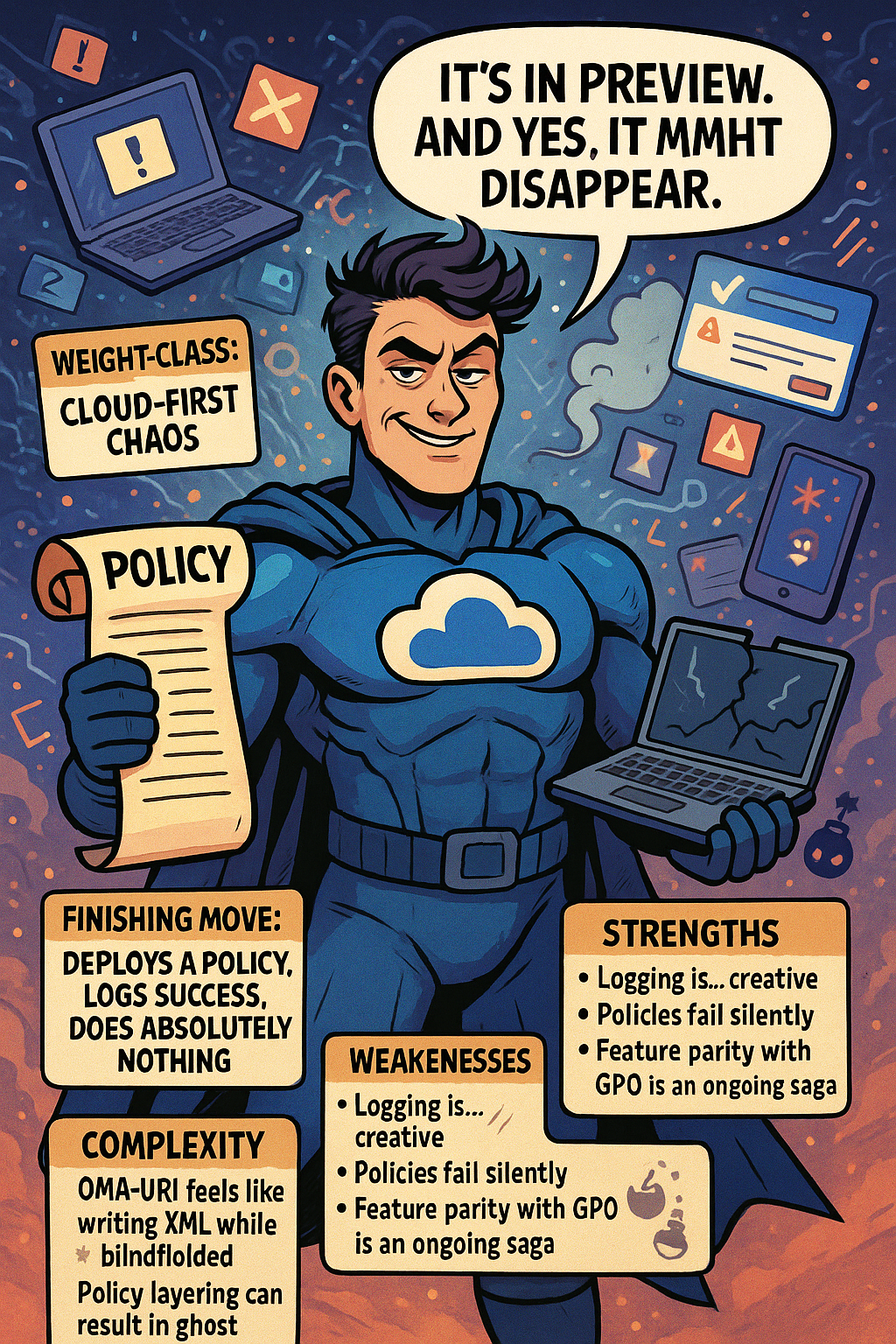“Sunday! Sunday! Sunday! Watch as two aging titans battle for dominance over your endpoints in a no-holds-barred policy deployment deathmatch!”
Welcome to the heavyweight fight of modern IT management: Microsoft Intune vs. Group Policy. One is a seasoned veteran from the on-prem glory days. The other is the slick, cloud-native upstart with a flair for modern chaos. If you've ever argued with your own scripts or had nightmares about conflicting policies, this post is your therapy session.
So buckle up, folks. This isn’t just a comparison — it’s a smackdown.
🥊 In the Blue Corner: Group Policy (aka Grandpa GP)

Weight Class: Legacy Bloatware
Finishing Move: Disabling your USB ports at random, then denying it
Catchphrase: “It worked on Windows 7 — what more do you want?”
Group Policy (aka GPO) is the tried-and-true method for managing Windows environments — and by “tried-and-true,” we mean “bloated and fragile.”
Strengths:
- Can manage nearly every aspect of Windows, from firewall rules to desktop background aggression.
- Offline functionality — no cloud? No problem. Just pray it syncs when it finally does connect.
- GPO's targeting granularity via OUs is legendary. Painfully precise, like using a sledgehammer to fix a watch.
- Still faster and more reliable for a lot of core policy scenarios.
Weaknesses:
- Debugging is an art form. One wrong click in the
Default Domain Policyand suddenly everyone’s screen saver isflying_toasters.scr. - Old-school interfaces that haven’t changed since Windows XP — because why modernize something nobody understands anyway?
- Naming conventions are a disaster:
Policy-FINAL-v2-REAL_FINAL. Classic. - Doesn’t play well with non-domain joined devices, remote users, or basically anyone working from anywhere modern.
Group Policy isn’t dead — it’s just extremely tired.
🔥 In the Red Corner: Microsoft Intune (aka Cloud Baby)

Weight Class: Cloud-First Chaos
Finishing Move: Deploys a policy, logs success, does absolutely nothing
Catchphrase: “It’s in preview. And yes, it might disappear.”
Intune is Microsoft’s modern endpoint management solution, built for the world where nobody’s in the office, every device is BYOD, and you’re expected to support it all from a browser tab while juggling five Teams calls.
Strengths:
- Internet-native: Policies apply from anywhere, no VPN tantrums required.
- Built-in Conditional Access and compliance integration with Entra ID and Defender.
- Automation ready: PowerShell, Proactive Remediations, compliance scripts… all deployable without needing to touch the device.
- Friendly-ish UI with dashboards that sometimes even work.
Weaknesses:
- Logging is… creative. Policies can fail silently, or worse — pretend they worked.
- Feature parity with GPO is an ongoing saga. Some settings? Still missing.
- Complex deployments like OMA-URI feel like writing XML while blindfolded and beeing tortured to eat ButterChicken with extra Spice🥵
- Policy layering can result in ghost settings that even Microsoft support can’t explain.
Still, Intune’s flexibility and cloud integration give it the edge for remote-first environments.
⚔️ Head-to-Head: Who Wins What?
| Feature | Group Policy | Intune |
|---|---|---|
| 💼 Policy Scope | 🥇 Covers everything Windows | ❌ Gaps still exist (but closing) |
| 🌐 Remote Management | ❌ Needs VPN | 🥇 Native cloud access |
| 🔍 Visibility | ❌ Event logs & prayer | 🥇 Dashboards & reporting |
| 🤕 Troubleshooting | 🔥 “Guess the culprit” | 🔥 “Guess what actually applied” |
| 🧠 Learning Curve | 😵💫 Steep but familiar | 😵💫 Modern but mysterious |
There’s no one-size-fits-all. But if you’re betting on the future, it’s wearing a hoodie and lives in the cloud.

🧨 Using Both: Who’s the Boss?
If you’ve got both GPO and Intune in play, congratulations — you’ve achieved hybrid hell 🫂. The question is: which one wins when both try to manage the same setting?
Meet MDM Wins Policy
Microsoft gave us a registry key to sort this out:
HKLM\SOFTWARE\Policies\Microsoft\Windows\MDMWinsOverGP
"MDMWinsOverGPEnabled"=dword:00000001
If that’s enabled, Intune takes precedence for supported policies. But — and this is a flaming dumpster-sized but — not every policy respects this. Some just duke it out in the background like it's Fight Club.
Logs will lie. Syncs will stutter. Support calls will happen.
Rule of Thumb
- If both are managing the same setting: expect chaos.
- If you're hybrid: test in staging before production.
- Document everything. Then document why that documentation is wrong.
🌟 Why Intune Is the Future
Yes, Intune can be infuriating. But let’s not ignore the good stuff.
☁️ Designed for the Real World
- Manage devices from anywhere — home office, train, or that weird coworking café in Vietnam where all the fancy people are.
- Support users who will never set foot in HQ again.
- Zero-touch Autopilot deployments make onboarding smoother than a helpdesk intern’s excuses.
🔐 Security That’s Actually Secure
- Native integration with Microsoft Defender, BitLocker, Conditional Access and all that other fancy stuff.
- Set compliance rules that actually stick (usually).
- Block non-compliant devices with surgical precision (sometimes).
🔄 Automation Done Right (ish)
- Push scripts, monitor outcomes, remediate silently.
- Use Proactive Remediations like a ninja sysadmin.🥷
- Trigger policy updates with minimal clicks — and maximum caffeine.
🎯 Smarter Targeting
- Forget OUs. Use dynamic groups, filters, tags.
- Assign based on real data like device model, OS version, or group membership.
Intune’s not perfect. But it’s made for today’s madness — remote work, BYOD, zero trust, hybrid everything. GPO just can’t keep up.
🛠️ Migrating from Group Policy to Intune: A Survival Guide
So you’ve decided to modernize. Bless your brave soul.
Step 1: Audit Everything
Start with a GPO inventory. Run GPResult, export GPOs, and paste it all into Excel if you're a masochist. Use Group Policy Analytics in Intune to see what can be migrated.
Step 2: Trim the Fat
Don’t lift and shift garbage. Migrate only what matters. If you don’t know what a GPO does, delete it and see who screams.
Step 3: Rebuild in Intune
Use the Settings Catalog, Admin Templates, or custom OMA-URIs (RIP your sanity).
Step 4: Test Like a Madman
Deploy to a test group. Break things safely. Document. Cry. Fix.
Step 5: Gradual Cutover
Use filters and assignment scoping to transition in waves. Avoid Friday afternoon rollouts unless you enjoy panic, or you got some free time on Monday.
Step 6: Clean Up the Corpses
Once settings are stable in Intune, go back and kill the GPO equivalents. Don’t let zombie policies roam free.
Pro Tip:
Don't aim for 1:1 parity. Aim for clarity, simplicity, and sanity.
💀 So Who Wins?
Truthfully? Nobody. You win some, you lose some, and then Microsoft moves the goalposts.
But if you’re starting fresh or leaning into cloud-first management — Intune is the way forward. Group Policy still has its place, especially in deeply entrenched on-prem setups. But for agility, scalability, and that sweet sweet Conditional Access? Intune takes the belt.
Just don’t expect it to work the first time. Or the second.
🎤 Final Thoughts
GPO is the seasoned grandmaster who can do it all, but has a drinking problem and yells at clouds. Intune is the ambitious millennial who forgets stuff but syncs your devices while you sleep.
In the end, it’s not about picking a winner — it’s about knowing when to use which. Or at least knowing who to blame when it all goes sideways.



